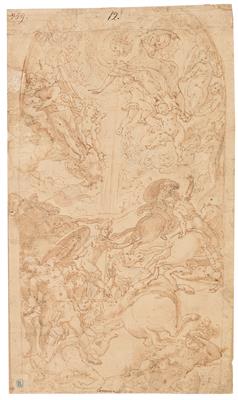Cristoforo Roncalli, gen. il Pomarancio attributed to

(1552–1626)
The Conversion of Saint Paul, pen and brown ink, brown wash, over black chalk, on laid paper, laid down on canvas, 43,5 x 25,5 cm, inscribed “Pomarancio” in the lower middle, numbered “259” at upper left, “12” in the middle, inscribed “Roncagli” and (Santi di) “Tito” in black chalk and an old handwriting on the reverse, mounted, unframed, (Sch)
Provenance:
Collection E. R. Lamponi-Leopardi (late 19th century), Florence and Turin, Lugt 1760; estate sale Florence, November 1902;
sale Galerie Bassenge, Berlin, 30th November 2018, lot 6422 (attributed to Cristoforo Roncalli);
private collection, Italy.
Literature:
R. Scholz, “Neu aufgefunden: Modello einer Caduta da cavallo von Cristoforo Roncalli”, in: Das Münster, Vol. 2, 2007, pp. 110–113.
On the occasion of the estate sale of the Conte Lamponi-Leopardi collection in Florence in November 1902 the catalogue mentioned a sheet „Conversion de St. Paul, Plume et bistre“ (J. Sambon / N. Ferri, Catalogue de la Collection Lamponi de Florence, Mailand 1902, p. 14, No 372) among the drawings of Santi di Tito.
It may be the present drawing due to its inscribed attribution to Santi di Tito on the reverse. The upright composition, whose top end is inscribed in a semicircle, shows the conversion of Saint Paul in an architectural setting. The V-shaped direction of movement in the scene is provided by the giant holder of a shield in the lower left corner who redirects the view to the center right of the depiction. In the centre of the event Saulus has been thrown from his horse by Christ who is pointing to Archangel Michael and appointing him to heaven’s assistant. Saulus had been travelling to Damascus on the high priest’s command to counter the new doctrine of the apostles. The present scene celebrates the new church by showing the dramatic moment when Saulus converted to Christian faith. Ralf Scholz considers the present drawing to be related with a composition of the fresco “Conversion of Saint Paul” in S. Maria Aracoeli in Rome, Capella della Valle (after 1584). According to Scholz the present sheet is a preliminary drawing for the fresco, which the artist eventually changed in order to radically alter and adapt the theme to meet the necessities of a niche. (Scholz 2007, p. 112). For Scholz the drawing is also related to another preliminary drawing for the fresco in the British Museum (Inv.1869,0813.880) which is different from the modello and was designed in the niche shaped format of a lunette. The London sheet may be a primo pensiero for the finally executed fresco. According to Dr. Rhoda Eitel-Porter the comparison with the drawing in the British Museums in fact seems worth considering; however, the upright format of the scene may also point to an altar piece of the same theme. Eitel-Porter dates the drawing between 1582 and 1586.
We are grateful to Dr. Rhoda-Eitel Porter for the scientific support.
An alternative attribution of the present drawing has recently by suggested by Dr. Marco Simone Bolzoni. In his opinion, the study could have been made by Tommaso Laureti (Palermo c. 1530-1602) who was active in Bologna and Rome. A comparable drawing with a study for the “Martyrdom of St. Catherine” is preserved in the Musée du Louvre, Paris (Inv. 1533). See: M.S. Bolzoni, “Tommaso Laureti: un nuovo disegno e qualche osservazione sul suo primo soggiorno romano”, in: Paragone, Vol. 3, Nr. 129-130, September - November 2016, p. 53-61.
Expert: Mag. Astrid-Christina Schierz
 Mag. Astrid-Christina Schierz
Mag. Astrid-Christina Schierz
+43-1-515 60-546
astrid.schierz@dorotheum.at
22.04.2021 - 15:12
- Odhadní cena:
-
EUR 4.000,- do EUR 6.000,-
- Vyvolávací cena:
-
EUR 3.000,-
Cristoforo Roncalli, gen. il Pomarancio attributed to
(1552–1626)
The Conversion of Saint Paul, pen and brown ink, brown wash, over black chalk, on laid paper, laid down on canvas, 43,5 x 25,5 cm, inscribed “Pomarancio” in the lower middle, numbered “259” at upper left, “12” in the middle, inscribed “Roncagli” and (Santi di) “Tito” in black chalk and an old handwriting on the reverse, mounted, unframed, (Sch)
Provenance:
Collection E. R. Lamponi-Leopardi (late 19th century), Florence and Turin, Lugt 1760; estate sale Florence, November 1902;
sale Galerie Bassenge, Berlin, 30th November 2018, lot 6422 (attributed to Cristoforo Roncalli);
private collection, Italy.
Literature:
R. Scholz, “Neu aufgefunden: Modello einer Caduta da cavallo von Cristoforo Roncalli”, in: Das Münster, Vol. 2, 2007, pp. 110–113.
On the occasion of the estate sale of the Conte Lamponi-Leopardi collection in Florence in November 1902 the catalogue mentioned a sheet „Conversion de St. Paul, Plume et bistre“ (J. Sambon / N. Ferri, Catalogue de la Collection Lamponi de Florence, Mailand 1902, p. 14, No 372) among the drawings of Santi di Tito.
It may be the present drawing due to its inscribed attribution to Santi di Tito on the reverse. The upright composition, whose top end is inscribed in a semicircle, shows the conversion of Saint Paul in an architectural setting. The V-shaped direction of movement in the scene is provided by the giant holder of a shield in the lower left corner who redirects the view to the center right of the depiction. In the centre of the event Saulus has been thrown from his horse by Christ who is pointing to Archangel Michael and appointing him to heaven’s assistant. Saulus had been travelling to Damascus on the high priest’s command to counter the new doctrine of the apostles. The present scene celebrates the new church by showing the dramatic moment when Saulus converted to Christian faith. Ralf Scholz considers the present drawing to be related with a composition of the fresco “Conversion of Saint Paul” in S. Maria Aracoeli in Rome, Capella della Valle (after 1584). According to Scholz the present sheet is a preliminary drawing for the fresco, which the artist eventually changed in order to radically alter and adapt the theme to meet the necessities of a niche. (Scholz 2007, p. 112). For Scholz the drawing is also related to another preliminary drawing for the fresco in the British Museum (Inv.1869,0813.880) which is different from the modello and was designed in the niche shaped format of a lunette. The London sheet may be a primo pensiero for the finally executed fresco. According to Dr. Rhoda Eitel-Porter the comparison with the drawing in the British Museums in fact seems worth considering; however, the upright format of the scene may also point to an altar piece of the same theme. Eitel-Porter dates the drawing between 1582 and 1586.
We are grateful to Dr. Rhoda-Eitel Porter for the scientific support.
An alternative attribution of the present drawing has recently by suggested by Dr. Marco Simone Bolzoni. In his opinion, the study could have been made by Tommaso Laureti (Palermo c. 1530-1602) who was active in Bologna and Rome. A comparable drawing with a study for the “Martyrdom of St. Catherine” is preserved in the Musée du Louvre, Paris (Inv. 1533). See: M.S. Bolzoni, “Tommaso Laureti: un nuovo disegno e qualche osservazione sul suo primo soggiorno romano”, in: Paragone, Vol. 3, Nr. 129-130, September - November 2016, p. 53-61.
Expert: Mag. Astrid-Christina Schierz
 Mag. Astrid-Christina Schierz
Mag. Astrid-Christina Schierz
+43-1-515 60-546
astrid.schierz@dorotheum.at
|
Horká linka kupujících
Po-Pá: 10.00 - 17.00
kundendienst@dorotheum.at +43 1 515 60 200 |
| Aukce: | Mistrovské kresby, Tisky do roku 1900, Akvarely a miniatury |
| Typ aukce: | Online aukce |
| Datum: | 22.04.2021 - 15:12 |
| Místo konání aukce: | Wien | Palais Dorotheum |
| Prohlídka: | online |
